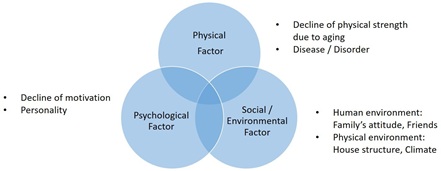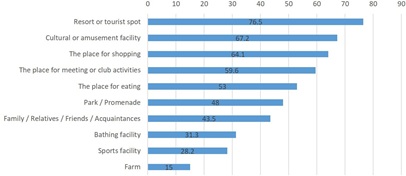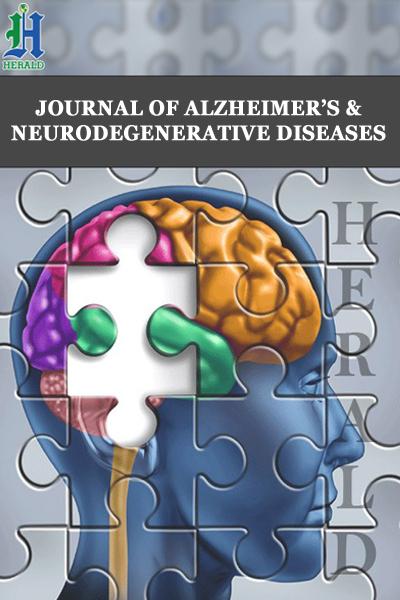
Journal of Alzheimers & Neurodegenerative Diseases Category: Clinical
Type: Commentary
Shopping Activities for Preventing Housebound
*Corresponding Author(s):
Yuki HayashiGraduate School Of Science And Engineering, Chiba University, Japan
Email:yu751@outlook.jp
Received Date: Aug 30, 2019
Accepted Date: Sep 20, 2019
Published Date: Sep 27, 2019
PROBLEMS AROUND ELDERLY PERSONS
In Japan, it has been important to take care of housebound elderly persons. Hatono, et al. Defined the state of housebound as those who went outdoors less than a few times a month, excluding elderly persons who were bedridden, those su?ering from dementia and those prohibited from going outdoors for medical reasons [1]. In the other survey, 2,932 elderly persons were classified in detail according to a frequency of going outdoors. In addition, as for the group of ‘Housebound’, 154 persons were classified into 4 types as follows [2].
Type1: An elderly person hardly goes outdoors alone but he/she has some social interactions.
Type2: An elderly person hardly goes outdoors alone and he/she has no social interactions.
Type3: An elderly person rarely goes outdoors alone but he/she has some social interactions.
Type4: An elderly person rarely goes outdoors alone and he/she has no social interactions.
Housebound may influence on many aspects of daily activities so it has been necessary in Japan to consider how to prevent housebound. Ministry of Health, Labor and Welfare showed a manual for preventing housebound and supporting the elderly persons [3]. In this manual, several factors of housebound were shown, that is, physical factor, psychological factor and social/environmental factor (Figure 1).
Type1: An elderly person hardly goes outdoors alone but he/she has some social interactions.
Type2: An elderly person hardly goes outdoors alone and he/she has no social interactions.
Type3: An elderly person rarely goes outdoors alone but he/she has some social interactions.
Type4: An elderly person rarely goes outdoors alone and he/she has no social interactions.
Housebound may influence on many aspects of daily activities so it has been necessary in Japan to consider how to prevent housebound. Ministry of Health, Labor and Welfare showed a manual for preventing housebound and supporting the elderly persons [3]. In this manual, several factors of housebound were shown, that is, physical factor, psychological factor and social/environmental factor (Figure 1).

Figure 1: Factors of housebound (based on [3]).
There are several risks related to housebound state. For examples, it may cause a decline of BADL (Basic Activities of Daily Living), IADL (Instrumental Activities of Daily Living) or cognitive functions. BADL includes walking, bathing or excreting and IADL shopping, washing, money management or medicine management [4].
RELATED WORKS
Ohashi thought that a motivation was important for elderly persons to go outdoors because they would be uncomfortable to be forced to go outdoors without any purposes, like chatting with other elderly [5]. Then we are going to discuss what types of motivation will be appropriate for elderly persons to go outdoors.
Mizuno pointed out an importance of purpose of going outdoors in addition to a way of going outdoors [6]. According to her survey (Figure 2), many of elderly persons wanted to visit unordinary places, “Resort or tourist spot” or “Cultural or amusement facility”, which maybe obvious. However, when they visit there, their companions, their physical abilities or transportation will become restrictions for them. According to the other survey “The Influence of Incontinence on Daily Life” conducted by Unicharm Corporation, more than 60% of 60’s and 70’s with experience of incontinence answered that they had felt anxiety about a long time trip.
Mizuno pointed out an importance of purpose of going outdoors in addition to a way of going outdoors [6]. According to her survey (Figure 2), many of elderly persons wanted to visit unordinary places, “Resort or tourist spot” or “Cultural or amusement facility”, which maybe obvious. However, when they visit there, their companions, their physical abilities or transportation will become restrictions for them. According to the other survey “The Influence of Incontinence on Daily Life” conducted by Unicharm Corporation, more than 60% of 60’s and 70’s with experience of incontinence answered that they had felt anxiety about a long time trip.

Figure 2: Places which elderly persons want to visit more frequently (multiple answers allowed) [6].
We consider it is quite di?cult to encourage elderly persons to unordinary places, which are usually far from their living areas. According to Figure 2, they also wanted to visit ordinary places, “The place for meeting or club activities” or “The place for shopping”. Following Figure 3 too, to prevent housebound, we can see it is important to encourage elderly persons to visit ordinary places in their daily life.

Figure 3: Places which elderly persons feel fun to visit (multiple answers allowed) [6].
We focused on a shopping activity because we considered it was more natural, essential and intellectual activity than the other IADL activities. Even in urban areas in Japan, it has recently become a big problem to deal with shopping refugees, who are not able to conduct their shopping activity by themselves. In the following chapter, we’ll review several researches for preventing housebound.
SHOPPING ACTIVITIES FOR PREVENTING HOUSEBOUND
Shopping rehabilitation®
At a store of Co-op Kobe, several volunteers experienced to support customers from elderly facilities [7]. The customers could walk about in the store using designated shopping cart which helps them walk and conduct their shop- ping activities communicating with volunteers, which would contribute walking training and preventing dementia [7].
Shopping Rehabilitation® (Figure 4) was developed by Hikari Project Inc. [8] this service aims to activate elderly persons, commercial facilities and local governments. As for the first one, 5 aspects of shopping activities would improve physical and psychological aspects of participants.
Shopping Rehabilitation® (Figure 4) was developed by Hikari Project Inc. [8] this service aims to activate elderly persons, commercial facilities and local governments. As for the first one, 5 aspects of shopping activities would improve physical and psychological aspects of participants.
 Figure 4: The process of Shopping Rehabilitation ® (with English translation by author).
Figure 4: The process of Shopping Rehabilitation ® (with English translation by author).Shopping therapy
Inoue introduced shopping therapy [9]. This therapy is one of the cognitive behavioral therapy and it mainly focuses on preventing dementia. Inoue showed some e?ects of shopping therapy [9].
In addition to the above e?ects, Inoue pointed out that shopping would become a chance for going outdoors. Elderly persons usually have few chances to be depended by other people. So if we ask elderly persons to visit a grocery store and purchase some items, we may encourage them to go outdoors with less physical and psychological stress through shopping activities.
- It will enhance participants’ physical strength.
- It will train participants’ judgment abilities.
In addition to the above e?ects, Inoue pointed out that shopping would become a chance for going outdoors. Elderly persons usually have few chances to be depended by other people. So if we ask elderly persons to visit a grocery store and purchase some items, we may encourage them to go outdoors with less physical and psychological stress through shopping activities.
Shopping care program
Machida et al. considered supporting elderly persons in their daily life. Even if the elderly person have a state of dementia, it is important for care givers to properly assess the abilities which the elderly person have and to improve it [10]. Machida et al. conducted a care program in a dementia persons’ group home to examine behavioral characteristics which 22 elderly persons can carry out and can’t.
According to this program, the only thing which the greater part of participants was not able to achieve was “Bringing a shopping basket and walking around to shopping” because they did not have a practice of using a shopping basket in their youth. In addition, cognitive functions were not examined particularly in this program.
According to this program, the only thing which the greater part of participants was not able to achieve was “Bringing a shopping basket and walking around to shopping” because they did not have a practice of using a shopping basket in their youth. In addition, cognitive functions were not examined particularly in this program.
CONCLUSION
In this paper, we introduced housebound problems and several approaches to prevent it. Especially we focused on shopping activities so that we could encourage elderly persons to visit ordinary places with less physical and psychological stress.
However, the approaches shown in this paper were not so easy to conduct especially for non-specialist (including family member). We should consider easier way to encourage shopping activities. In addition, the intellectual aspects of shopping activities were not shown su?ciently. We should consider how to evaluate the intellectual aspect of a shopping activity for preventing housebound.
However, the approaches shown in this paper were not so easy to conduct especially for non-specialist (including family member). We should consider easier way to encourage shopping activities. In addition, the intellectual aspects of shopping activities were not shown su?ciently. We should consider how to evaluate the intellectual aspect of a shopping activity for preventing housebound.
REFERENCES
- Hatono Y, Tanaka H, Furukawa K, Masuda K (2001) Housebound of Elderly Individuals in the Community and Its Background Factors, Journal of Japan Academy of Community Health Nursing 3: 26-31.
- Watanabe M, Watanabe T, Matsuura T, Kawamura K, Kono K (2005) Incidence of Disability in Housebound Elderly People Living in a Rural Community. Nihon Ronen Igakkai Zasshi 42: 99-105.
- Ministry of Health, Labor and Welfare (2012) A Manual for Preventing Housebound and Supporting the Elderly Persons. A Manual for Preventive Care (Revised Edition) 2012: 97-111.
- Eto F, Tanaka M, Chishima M, Igarashi M, Mizoguchi T, et al. (1992) Comprehensive Activities of Daily Living (ADL) Index for the Elderly. Nihon Ronen Igakkai Zasshi 29: 841-848.
- Ohashi M (2016) To Encourage Elderly Persons to Go Out: Motivation and Relieving Concern, The Nikkei, Evening paper, 14th December (2016).
- Eiko M (2004) About Elderly Person’s Travel Behavior, Life Design Report, Dai-ichi Life Research Institute Inc.
- Kida C (2016) Shopping Rehabilitation: Co-op Kobe Supports Their Customers, The Mainichi, Morning paper, 14th July (2016).
- http://act.upper.jp/works/cart/
- https://ninchisho-online.com/archives/13708/
- Machida K, Uchida Y, Kotani Y (2006) Behavior Characteristics in Shopping and a Money Management of Dementia Senior Citizens. Kitakanto Med J 56: 225-230.
Citation: Hayashi Y, Abe A(2019) Shopping Activities for Preventing Housebound. J Alzheimers Neurodegener Dis 5: 029.
Copyright: © 2019 Yuki Hayashi, et al. This is an open-access article distributed under the terms of the Creative Commons Attribution License, which permits unrestricted use, distribution, and reproduction in any medium, provided the original author and source are credited.
© 2025, Copyrights Herald Scholarly Open Access. All Rights Reserved!

